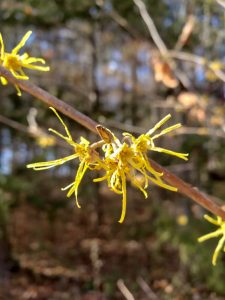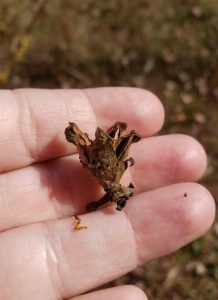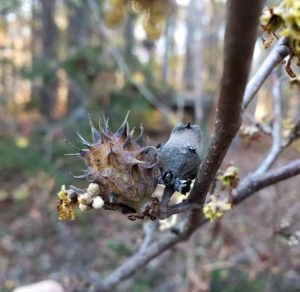 By Laura Warman, Grants Manager
By Laura Warman, Grants Manager
It’s early November, and although colorful leaves are the stars of the show, there’s still time to find flowers in the woods. You may know witch-hazel as a liquid you can by in the first aid or beauty section of a pharmacy – but did you know it comes from a locally native plant?
Witch hazels are shrubs and small trees in the genus Hamamelis. Of the five existing species, two are native to Asia and three are native to North America. American witch hazel (Hamamelis virginiana) is the species native to the Triangle and it grows all along the East Coast from Canada to Mexico. Witch hazels are woodland understory plants, they usually grow to about 15 feet tall and can spread their branches out, seeking the light that filters through the canopy of taller trees. Forked and zig-zagging twigs are one of the tell-tale signs for identifying these plants in the wild.
The leaves and bark of Hamamelis virginiana have been used medicinally for a long time. Native Americans made witch hazel poultices and teas to reduce inflammation and fever, as well as for eye and skin irritation. A series of compounds in the leaves and bark (mainly tannins) have antiseptic and astringent properties, so today witch hazel extract continues to be used in cosmetics and pharmaceuticals to reduce skin irritation (including bug-bites and poison ivy rashes), itching, and bruising.
Having it just been Halloween, you might be wondering what all this has to do with witches, but the answer might not be quite what you expect. Rather than anything related to casting spells, the name “witch hazel” probably comes from Europeans using the forked witch hazel branches to dowse for water. Also known as water-witching, the term comes form the Old English “wych” (or ‘wiche’) in reference to bending branches while dowsing.
Witch hazels flower in the fall and winter, which makes them an important source of food for pollinators (like winter moths) during these times of year. Each flower has four long, ribbon-like, wrinkly petals, and they grow in clusters on the stems, which makes them look like little fireworks or sunbursts. Some people say the flowers are “spidery,” but somehow, they always make me think of butterfly wings that are fresh out of the chrysalis and haven’t had time to iron themselves out. American witch hazel has bright yellow flowers that appear in October and November, sometimes even before all the leaves (which also turn yellow) have finished falling off the branches.
Once they are pollinated, the flowers go dormant and the seeds develop in little woody fruits that will take a year to mature. Unlike many temperate plants, this means that witch hazels bear fruits and flowers, as well as fuzzy leaf buds all at the same time. When the seedpods dry out, they literally pop open loudly, and the seeds are shot out – up to 30 feet away from the tree – a process biologists call “ballistic dispersal.”
Because witch hazels bloom so late (early?) in the year and are such hardy plants, they are quite popular as garden shrubs, and there are over 25 varieties available for sale. Other common names for these plants include Winterbloom, Snapping Hazelnut, and Striped Alder. Often the commercially available witch hazels are a hybrid of the Asian species, so it’s good to be on the lookout for the native species instead. One of the best ways to tell them all apart is that American witch hazel blooms yellow and in fall, while the Asian species bloom later in winter. Hamamelis vernalis, the Ozark witch hazel, grows further West than NC, and has red-to-orange blooms from January to March. If you are trying to replace non-native plants in your garden with native species, witch hazel is a great replacement for Forsythia, which is not native and can become invasive.
Lastly, if you are out in the woods and come across a clump of witch hazel, take a close look at the branches, and you might find some spiny growths in addition to the woody fruits and the flowers. Spiny witch hazel fall aphids lay their eggs in dormant flower buds, which causes the plant to create the galls.
It’s a great time of year to go out and look for blooming witch hazels – and to see if you can find aphid galls as well. See you out there!



